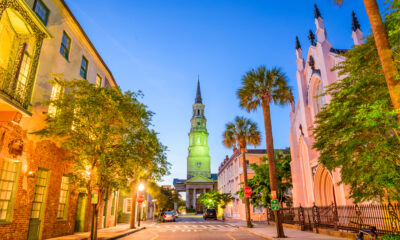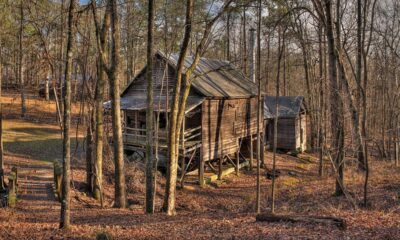Arkansas
How de Soto’s visit to Arkansas triggered the collapse of Nodena civilization
Published
1 month agoon
By
Leo Heit
De Soto’s Alliance Wars That Destroyed the Nodena
In 1541, Hernando de Soto led 600 men across the Mississippi into Arkansas, stepping into a power struggle between rival chiefs.
Casqui rushed to meet the Spanish, giving gifts and his daughter to gain allies against his enemy Pacaha. Both chiefs ruled from towns ringed by wooden walls and water moats.
Soon after, Casqui warriors and Spanish soldiers raided Pacaha’s sacred temple.
De Soto then brokered a shaky peace and stayed 40 days with Pacaha, who tried to outdo Casqui’s gifts. Within a century, this once-crowded region stood nearly empty.
Smallpox and political chaos had wiped out the Nodena people.
The story of this first contact unfolds at Arkansas’s Eaker Site, where a 50-acre village once housed 400 homes.

Spanish Adventurers Made First Contact in Arkansas
De Soto and his 600 men crossed the Mississippi on June 18, 1541, becoming the first Europeans to set foot in Arkansas. For two years, they looked for gold across the Southeast, following tips from local tribes.
Their first meeting in Arkansas was with the Aquixo people, who showed up in 200 war canoes with warriors wearing bright paints and feathers.
The Aquixo leader brought fish and plum bread while telling the Spanish about a stronger chief named Pacaha who lived upriver.

Two Enemy Chiefs Ruled the Land
The Spanish soon learned about two powerful rivals in northeastern Arkansas: Chief Casqui and Chief Pacaha. Both men controlled large areas with many smaller villages under them.
Their people lived in a clear ranking system common in Mississippian culture.
Years of fighting forced both groups to build strong defenses around their towns, including wooden walls and water-filled ditches.
Spanish writers noted these were some of the biggest, most organized villages they had seen in the Southeast.

Casqui Walked a Mile to Meet the Strangers
Chief Casqui left his protected town and walked over a mile to greet the Spanish, bringing food, clothes, and animal skins as gifts. Unlike most first meetings between natives and Europeans, this one started peacefully.
A long dry spell had ruined Casqui’s corn crops, making his people hungry.
Hoping to get Spanish weapons to use against Pacaha, Casqui offered his daughter to marry de Soto to form a military bond with these newcomers.

Rain Falls After Spanish Prayer Ceremony
Casqui asked de Soto to pray to the Christian God for rain to save their dying corn fields. The Spanish leader told his men to build a large wooden cross on top of the mound where Casqui lived.
Catholic priests held a Christian ceremony around this cross, and Spanish records say rain fell the very next day.
This lucky timing made Casqui’s people think de Soto had amazing powers that could help them against their enemies.

Gold Rumors Led to a Deadly Attack
Casqui told de Soto that Pacaha’s people had gold, knowing this would trick the Spanish into attacking his longtime enemy.
The Spanish, always eager to find precious metals, agreed to help fight against Pacaha’s territory. Soldiers from both groups joined forces and got ready to attack Pacaha’s main town.
This clever lie set up a raid that would damage sacred sites and upset the power balance between the rival chiefs.

Warriors Destroyed Sacred Family Relics
The joint Spanish-Casqui attack caught Pacaha’s town completely off guard.
Casqui’s warriors broke into Pacaha’s temple and smashed sacred family relics stored there, going beyond normal fighting into religious harm.
Spanish writers were impressed by the size and strong defenses of Pacaha’s town but found no trace of the promised gold. Chief Pacaha escaped during the attack, leaving his people and property open to looting and damage.

De Soto Played Peacemaker Between Rivals
De Soto reached out to the escaped Chief Pacaha, saying he wasn’t responsible for the attack and offering peaceful talks. Pacaha heard that the Spanish planned to attack him again and quickly returned the stolen items.
De Soto arranged a dinner meeting between the two enemy chiefs to work out a shaky peace deal. This forced handshake temporarily stopped a conflict that had lasted for generations between the two powerful groups.

Marriage Offers Became a Competition
Chief Pacaha gave de Soto one of his wives, his sister, and another woman to create a stronger bond than Casqui had offered.
This move tried to outdo Casqui, who had only offered his daughter as a bride to the Spanish leader.
These "marriages" worked as political tools meant to build lasting connections between each chief and the Spanish visitors. The competition between the chiefs continued even as they tried to win favor with the Europeans.

Spanish Stayed for Forty Days
De Soto’s group camped at Pacaha’s town for 40 days, using it as a home base while they looked around the area. Small groups of Spanish scouts went north to keep searching for gold and to check out travel routes.
The long Spanish stay upset local food supplies and political systems throughout the region. The visitors ate huge amounts of corn and other foods that the Nodena people needed to survive through the year.

De Soto’s Death Ended the Expedition
De Soto died in May 1542 near the Mississippi River, bringing an end to the Spanish presence in Arkansas. The remaining Spanish gave up their mission and slowly made their way back to Mexico.
No other Europeans would write about meeting the Nodena people for the next 132 years.
The fragile peace between Pacaha and Casqui likely fell apart after de Soto left, and the old pattern of warfare probably started up again.

A Thriving Culture Vanished Without a Trace
When the next Europeans (Marquette and Jolliet) showed up in 1673, they found the once-crowded region almost empty.
The area that de Soto called "the most populous they had seen in La Florida" now had only a few Quapaw people living there.
European diseases like smallpox and measles, combined with the upheaval of local power structures, caused a complete population crash.
The once-thriving Nodena civilization disappeared entirely, leaving behind only buried artifacts as proof of their complex society.

Visiting Eaker Site, Arkansas
The Eaker Site near Blytheville is where Spanish explorer Hernando de Soto first met the Nodena people in the 1540s.
This National Historic Landmark from 1996 sits on former Eaker Air Force Base land owned by the City of Blytheville.
Researchers have found 80 underground features using special equipment, including house floors and defensive walls.
Contact the Arkansas Archeological Survey’s Blytheville office for information about visiting this important archaeological site.
This article was created with AI assistance and human editing.
Read more from this brand:
Currently residing in Phoenix, Arizona with his wife and Pomeranian, Mochi. Leo is a lover of all things travel related outside and inside the United States. Leo has been to every continent and continues to push to reach his goals of visiting every country someday. Learn more about Leo on Muck Rack.


Walk the Seven Hollows trail where one doctor’s eavesdropping saved Arkansas forests

The forgotten Alaska connection to Seattle’s groundbreaking 3.7 million visitor World’s Fair

The moment America officially fractured in two is remembered at this Alabama star

Meet the blind teacher who defied politicians and built West Virginia’s first disability school in Romney

Why did it take 17 years and one stubborn Ohioan to build this WWII memorial?

12 Reasons Why You Should Never Ever Move to Florida

Best national parks for a quiet September visit

In 1907, Congress forced Roosevelt to put God back on U.S. coins. Here’s why.

The radioactive secret White Sands kept from New Mexicans for 30 years

America’s most famous railroad photo erased 12,000 Chinese workers from history
Trending Posts

 Pennsylvania3 days ago
Pennsylvania3 days agoHere Are 12 Things People from Pennsylvania Do That Seem Insane To Everyone Else

 North Carolina4 days ago
North Carolina4 days agoHere Are 12 Things People from North Carolina Do That Seem Insane To Everyone Else

 Nebraska6 days ago
Nebraska6 days agoHere Are 12 Things People from Nebraska Do That Seem Insane To Everyone Else

 Maine5 days ago
Maine5 days agoThe ruins of a town that time forgot are resting in this Maine state park

 New York4 days ago
New York4 days agoHere Are 12 Things People from New York Do That Seem Insane To Everyone Else

 South Carolina2 days ago
South Carolina2 days agoHere Are 12 Things People from South Carolina Do That Seem Insane To Everyone Else

 Ohio4 days ago
Ohio4 days agoHere Are 12 Things People from Ohio Do That Seem Insane To Everyone Else

 Georgia5 days ago
Georgia5 days agoThis plantation’s slave quarters tell Georgia’s slowest freedom story
